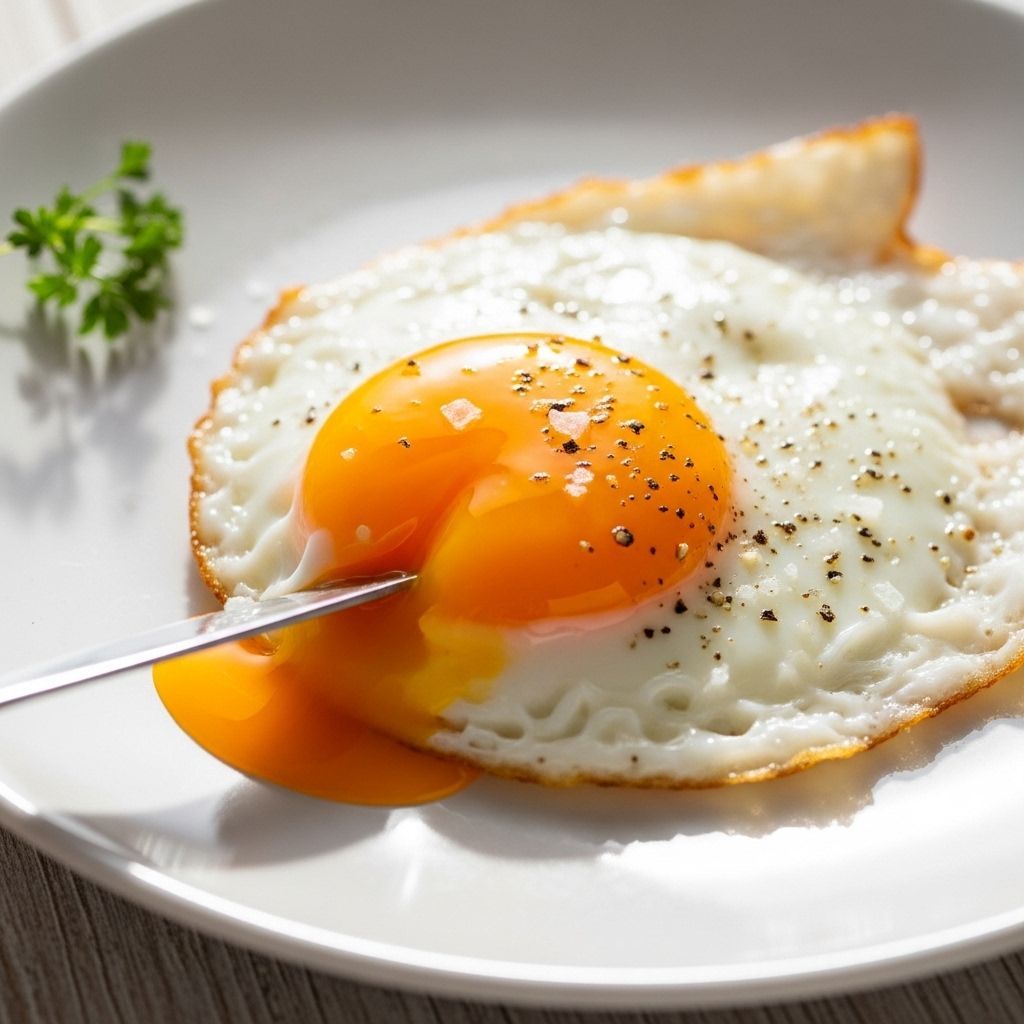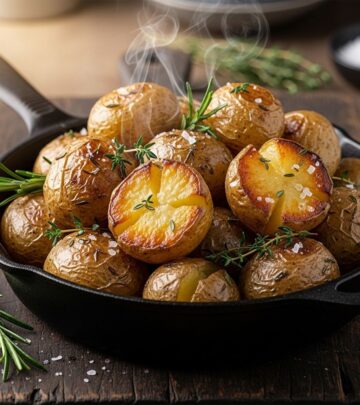Over-Easy Eggs Recipe: 7 Steps To Perfect Runny Yolks
Master the art of over-easy eggs with flawless whites and rich, runny yolks every time.

Image: HearthJunction Design Team
How to Make Perfect Over-Easy Eggs
Few breakfast foods match the simple perfection of over-easy eggs, featuring firm, tender whites and golden, runny yolks. Whether you’re making a hearty breakfast plate or building the perfect sandwich, mastering this classic egg preparation can elevate your morning meal. This guide walks you through step-by-step instructions, essential kitchen tools, ingredient advice, cooking techniques, serving ideas, and frequently asked questions—so you’ll enjoy flawless over-easy eggs every time.
What Are Over-Easy Eggs?
Over-easy eggs are fried eggs cooked on both sides: the egg is flipped once the whites are mostly set, then cooked briefly on the second side. The goal is to achieve fully set whites while keeping the yolk gorgeously runny and intact until you cut it open. Unlike sunny-side-up eggs, which are only cooked on one side, over-easy eggs have a thin, opaque layer of white covering the yolk after flipping. If you prefer firmer yolks, you might try over-medium or over-hard styles, where the yolk is cooked more thoroughly.
Ingredients & Equipment
- Eggs: Choose high-quality, large eggs. Farm-fresh eggs, if available, offer vibrant yolks and richer flavor.
- Butter: Butter imparts a rich, savory flavor. Alternatives like avocado oil, olive oil, or bacon grease also work well.
- Salt and Pepper: Just a sprinkle of kosher salt and freshly ground black pepper enhances the natural egg flavor.
- Skillet: A nonstick skillet is recommended for easy flipping and release, but a well-seasoned cast iron or stainless steel pan also works.
- Spatula: Use a thin, flexible spatula for gentle flipping to keep yolks intact.
Step-by-Step: Cooking Over-Easy Eggs
- Preheat the Skillet
Set your skillet over medium-low heat and allow it to fully preheat. Add a small knob of butter (about 1/2 tablespoon) or a drizzle of oil to coat the pan. Swirl to cover the cooking surface evenly. - Crack the Eggs
Crack eggs one by one into a small bowl (to remove any shell fragments), then gently slide them into the skillet. Give the eggs a little space so the whites don’t run together. - Cook the First Side
Let the eggs cook undisturbed. Watch as the whites begin to set around the edges and turn opaque, but the yolk remains runny and bright. This typically takes about 1.5–2 minutes depending on the heat and skillet. - Season
Sprinkle eggs with salt and pepper to taste as they cook. - Flip Gently
When the whites are almost fully set (but still a bit translucent near the yolk), slide the spatula under each egg. In a smooth, confident motion, flip the egg over. Avoid pressing down, which can break the yolk. - Cook the Second Side
Let the eggs cook for another 15–30 seconds for classic over-easy with very runny yolks. For over-medium, leave for 30–45 seconds; for over-hard, about 1 minute. - Serve Immediately
Use the spatula to lift eggs from the pan and plate immediately. Over-easy eggs are best enjoyed hot, with the yolk ready to spill over toast, hash, or any breakfast side.
Tips for Perfect Over-Easy Eggs
- Use Fresh Eggs: Fresher eggs hold their shape better and are less likely to spread out in the pan.
- Maintain Medium-Low Heat: Cooking on low to medium heat ensures whites cook through without burning or toughening.
- Don’t Crowd the Pan: Give each egg enough space so whites cook evenly and flipping is easier.
- Thin Spatula Matters: A flexible, thin spatula slides under eggs easily, reducing the risk of breaking yolks.
- Nonstick Is Your Friend: A nonstick pan minimizes sticking and makes for a smooth flip.
- Butter Adds Flavor: For classic diner taste, use butter or bacon grease.
Over-Easy vs. Other Fried Egg Styles
| Egg Style | Cooking Method | Yolk Texture | Whites |
|---|---|---|---|
| Sunny-Side-Up | Cooked on one side, never flipped | Runny | Fully or mostly set; thin uncooked layer may remain on top |
| Over-Easy | Cooked on both sides, flipped once | Runny | Completely set |
| Over-Medium | Cooked on both sides, flipped once | Jammy, slightly set | Completely set |
| Over-Hard | Cooked on both sides, flipped once, longer cook | Fully set | Completely set |
Serving Suggestions
- Classic Breakfast Plate: Serve with crispy bacon, sausage, hash browns, and buttered toast.
- Layered on Avocado Toast: Top whole-grain toast with smashed avocado and over-easy egg; finish with chili flakes.
- Breakfast Sandwich: Stack on an English muffin or croissant with cheese, ham, and leafy greens.
- Over Vegetable Hash: Slide a runny egg over sautéed potatoes and peppers for a hearty brunch.
- Grain Bowls: Add to rice, farro, or quinoa bowls for extra protein and creaminess.
Common Mistakes and How to Avoid Them
- Eggs Stick to the Pan: Ensure your pan is well-oiled and preheated. Nonstick pans help prevent sticking.
- Yolk Breaks During Flip: Flip gently and use a wide, thin spatula. Practice helps!
- Whites Are Overcooked: Use moderate heat and avoid leaving eggs in the pan too long after flipping.
- Runny Whites: Wait until the whites are mostly set before flipping. If desired, cover the pan briefly to speed the process without flipping too soon.
Nutrition Information (Per Large Egg)
- Calories: ~70
- Protein: 6 grams
- Fat: 5 grams
- Carbohydrates: < 1 gram
- Cholesterol: ~185 mg
Eggs are also a good source of vitamin B12, riboflavin, selenium, and choline.
Frequently Asked Questions (FAQs)
How are over-easy eggs different from sunny-side-up eggs?
Over-easy eggs are flipped for a brief cook on the second side, covering the yolk with a thin layer of cooked white, while sunny-side-up eggs are only cooked on one side, leaving the yolk exposed and fully runny.
How do I avoid breaking the yolk when flipping eggs?
Use a thin, flexible spatula and flip with a gentle wrist motion. Let the whites set before flipping, and don’t rush the process.
Can I use oil instead of butter?
Absolutely. Neutral oils like canola, avocado, or olive oil work well. For extra flavor, try bacon grease or ghee.
What’s the best pan for over-easy eggs?
A high-quality nonstick skillet is ideal for preventing sticking, but a well-seasoned cast iron pan also works if properly maintained.
How do I make more than two eggs at once?
Use a larger skillet and leave adequate space between each egg. You may need to flip each one individually to prevent the yolks from colliding.
What if I prefer a less runny yolk?
Simply leave the eggs on the second side longer—for over-medium, cook 30–45 seconds; for over-hard, cook about a minute until the yolk is fully set.
Pro Tips for Egg Mastery
- Crack eggs into a small bowl first, then add to the pan—this helps control placement and prevents shell fragments.
- For extra creamy whites, add a teaspoon of water to the pan and cover briefly after flipping.
- If making eggs for a crowd, keep cooked eggs warm on a low oven setting (about 200°F/93°C) while you finish the batch.
- Experiment with seasoned salts, fresh herbs, or hot sauce for a unique twist.
Conclusion
Over-easy eggs are a timeless breakfast staple, beloved for their delicate texture and rich, runny yolk. With just a few ingredients and the right technique, you can create restaurant-quality eggs at home. Remember to use fresh eggs, maintain the right pan temperature, and flip gently for perfect results. Once mastered, over-easy eggs can become the crowning touch of your morning routine.
References
- https://www.allrecipes.com/recipe/284781/over-easy-egg/
- https://www.allrecipes.com/recipe/284783/eggs-over-easy/
- https://www.allrecipes.com/recipe/284853/eggs-over-easy-with-potato-hash/
- https://www.allrecipes.com/article/how-to-make-perfect-fried-eggs/
- https://littlespoonfarm.com/how-to-make-perfect-over-easy-eggs/
Read full bio of Srija Burman












